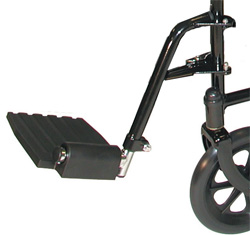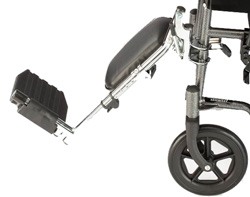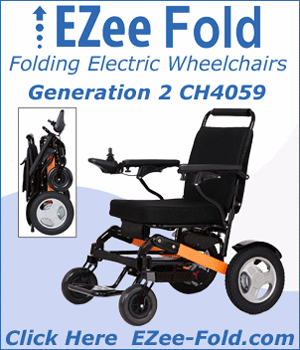
Conventional Footrest
Footrest or Leg rest?
The first thing a user needs to know when choosing a foot support option for their wheelchair is the difference between footrests and leg rests and which would be more suitable for their circumstances.
Footrests have a fixed angle relative to the seat of the wheelchair and are normally removable. They are usually between a 60 and 90 degree angle and the angle can not be changed.
A 90 degree footrest will position the lower leg straight down with a 90 degree bend at the knee. For most adults 90 degree footrests are not useable because they will either hit the floor or the casters. The 90 degree footrests are commonly used for children.
A 70 degree footrest positions the foot forward to avoid interfering with the casters and to allow for longer leg lengths. People with long lower legs may still have problems with the 70 degree footrests hitting the ground.
A 60 degree footrest positions the foot farther forward than the 70 degree or 90 degree and will allow for longer leg lengths. If a user frequents areas of rough terrain they may choose 60 degree footrests because the ground clearance will be greater than the other options.

Legrest
Leg Rests on the other hand have an adjustable angle, are removable, and are often described as or called" elevating leg rests". They can be set at any angle between about 70 degrees and 180 degrees (level with the seat frame with no bend at the knee) and will have calf pads that will support the lower part of the leg when elevated.
They can be set independently for length and angle. If a user has a cast or brace on one leg that keeps it from bending the leg rest for that leg can be fully elevated to support the leg and foot. The other leg can be adjusted to an angle and length where comfortable.
Basic leg rests are designed to be always used at the same elevation and can be set up to fit properly at a given elevation. If the elevation needs to be changed the length will have to be readjusted.
Articulating Leg Rests are those that extend as they are elevated. This is an important feature for those who need to be able to change the angle of the leg rests from time to time.
When the knee is extended (straightened), the leg length from the base of the spine to the bottom of the foot actually gets longer so a leg rest that has its length adjusted while in the lowered position will be too short when elevated. Articulated leg rests will adjust in length when elevated and lowered.
Wheelchair Turning Radius
Because the overall length of the wheelchair affects the turning radius (amount of space required to turn the wheelchair in a circle) it is normally desirable to have foot rests or leg rests that position the feet back as close to the wheelchair as possible. Therefore 90 degree footrests are optimal while 60 degree footrests are the least desirable.
However, as with other wheelchair features, some compromises will likely be needed to get some foot support that is functional and comfortable.


 Online Vendors
Online Vendors  US Online Vendors
US Online Vendors 
